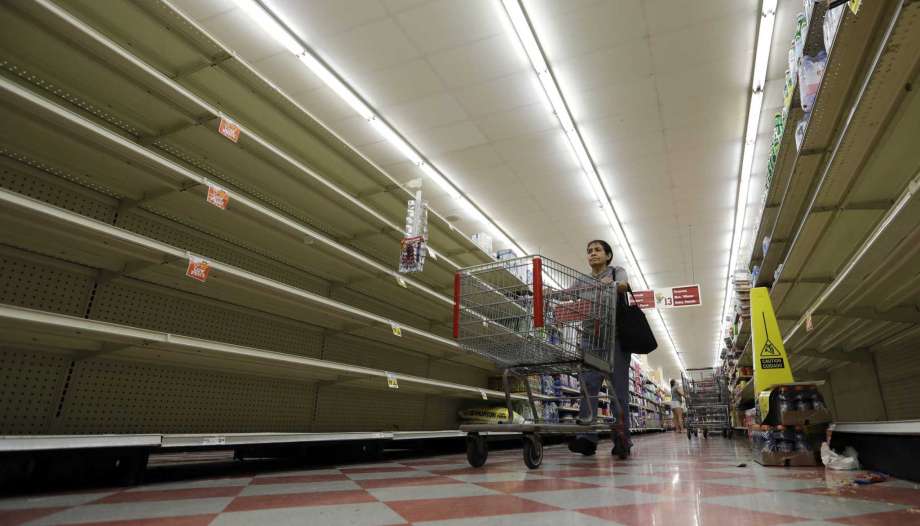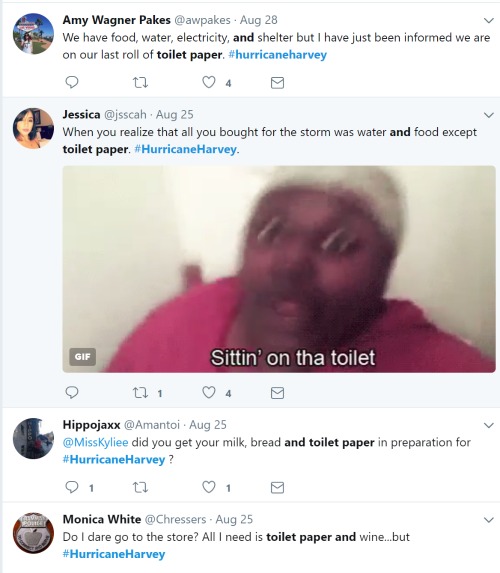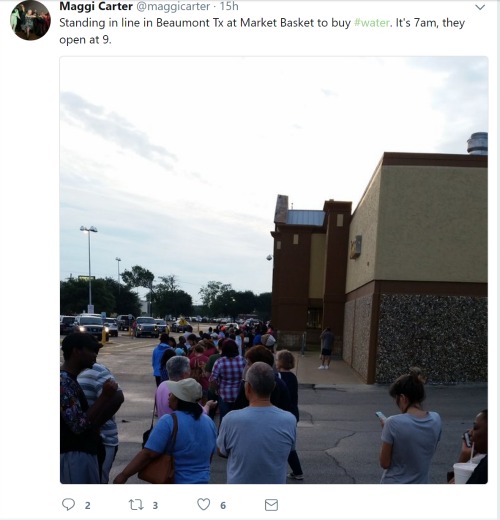
Amid the images of loss and destruction, hurricane survivors know they must restock provisions to prepare for another week or more of sheltering in place. Now, imagine 6.2 million people trying to stock up at the same time. Panic buying is gripping the affected area and beginning to overload local and regional communities. Ahead of the hurricane making landfall the vast majority of people simply figured that the aftermath would, at most, last a few days. No one ever contemplated that real possibility that this scenario would be the end result or believed they would have to evacuate after the storm hit.
In fact, many have evacuated the city and moved to other Texas towns and now those areas are beginning to exhaust supplies as well. In any disaster, when the needs of the people are strained, frustration can quickly descend into a breakdown. While this is something no one wants to see happen, with a disaster such as this one, it is very easy to see how it can overwhelm government emergency response plans.
In an article explaining the breakdowns that occur after disasters, it was written, “When the needs of the population cannot be met in an allotted time frame, a phenomenon occurs and the mindset shifts in people. They begin to act without thinking and respond to changes in their environment in an emotionally based manner, thus leading to chaos, instability and a breakdown in our social paradigm.”
This is what is to be expected when so many people are hit with a rapid, far from equilibrium event. Keeping up with the desperate and immediate demands of hundreds of thousands of people will undoubtedly be a challenge in and of itself and supply trucks can only do so much, especially with flood water still standing on highway systems. Those living in this aftermath have a long road ahead of them, and knowing which items disappear off the shelves first can help them better prepare and stay on top of their personal supplies.
Just 72 hours after this disaster, here are the five supplies that have become difficult or impossible to find.
Gasoline
Concerns over closed refineries and disrupted pipelines erupted into a full-blown panic run on gasoline across Texas cities. Here’s the crazy thing, the shortages are not just happening in the greater Houston area, but two hundred miles north in Dallas, as well as in the cities of Austin and San Antonio, TX.
Water
Clean drinking water, the main staple in any disaster supply, is quickly being purchased faster than they can restock it. If hurricane victims do not have a high-quality water filter, they have to take their chances of finding a store that has been restocked. In the flood-ravaged areas, critical infrastructure has been damaged making it difficult for trucks to resupply the affected area, thus adding to the panic buying. Desperate residents do not know when this disaster area will normalize, so they want to grab supplies when they can to ensure their family has what they need.
In the city of Beaumont, things have become dire since the city shut off the municipal water supply, leaving 100,000 people with no other option but to hunt for water in surrounding areas. As well, the local hospital had to close its doors out of fear of water contamination, one of many immediate post-disaster threats we discussed in a previous article.
CNN reports that city officials plan to establish a water distribution point on Friday.
Meanwhile, earlier Thursday, residents lined up at stores hours before they opened in hopes of getting whatever bottled water they could find.
— Maggi Carter (@maggicarter) August 31, 2017
“It’s crazy,” said Khayvin Williams, who started waiting in line at Market Basket at 6:50 a.m. “People are freaking out.”
At a local Wal-Mart, Jeffrey Farley said the store was only allowing 20 people in at a time and was rationing water to three cases per customer. He got in line at 6:30 a.m. and waited until 8:30 to get his water.
Food Staples
The first food items that will sell out mostly consist of things that are already cooked or prepared in some way, including canned foods, frozen dishes, and bread. Fresh meat and eggs would also disappear pretty fast, despite the fact that they need to be cooked.
And that is what we are seeing now. Food staples like milk, bread, and eggs are all in high demand. Lines are forming outside of stores that are open to the public and these essential items run out fast. In fact, grocery stores are putting limits on how much you can buy. In this report, one store manager in the area admits to the food limits. “Yeah, there’s limits,” Luis Castillo, a store employee who was working crowd control Tuesday, told BuzzFeed News. “But we already ran out of bread. There’s no more bread.” While many grocery stores and superstores like Wal-Mart and Target are opening more stores every day, at the given moment, it’s a race to resupply and stores can quickly be exhausted of food necessities.
Food staple shortages are also being reported in North Texas – 200 miles away from Houston.

Bleach
Most people may not have even considered this essential post-disaster item.
In the aftermath, bleach and chemical disinfectants are hard to come by. Cleaning flooded homes and questionable water sources are making this a high-demand commodity. Sanitation is one of the most important facets of staying prepared. After a hurricane hits, overloaded sewage systems will start spewing raw sewage. Diseases such as cholera, are contracted through contaminated water and food, and often occur as a result of poor hygiene and sanitation practices.
Moreover, cleaning supplies like gloves and garbage bags are also needed by many in the disaster area and those in the relief efforts have all listed cleaning supplies as a needed item.
Toilet Paper
Hurricane survivors may have grossly underestimated how much toilet paper they needed to ride out the aftermath. Toilet paper is used every day and when it runs out, things can get nasty.
On average, consumers use 8.6 sheets per trip – a total of 57 sheets per day. Multiply that by a week-long storm and a family of 5 and you run out quickly.
Due to the high need for toilet paper, it is flying off the shelves and restocking has obviously become an issue.

Home Repair Supplies
The last thing on people’s minds was how massive the clean up from Hurricane Harvey would be. But as we have often noted, hurricanes are unpredictable in nature and this one “threw a wrench” in many preparedness plans.
While thinking about how they were going to clean up after flood waters ravaged their homes wasn’t something anyone really considered beforehand, is it now at the forefront. As a result of the extensive damage, home repair supplies are in desperate need.
Plywood, tools, wheelbarrows, large plastic containers, trash bags, buckets, generators, and other disaster necessities are being purchased. In fact, at Lowe’s, Rick Neudorff, the retailer’s emergency command center operations manager said generators were in such high demand that “some stores are practically selling generators off the back of the truck because people have been waiting in the stores for the generators to arrive.”
The reality is that the vast majority of people have about three days of food and water at home, when a prolonged disaster strikes it upends the stability of the entire system of just-in-time delivery.
This is why using a layered approach to preparedness planning that includes short-term, long-term and worst-case scenario considerations is paramount.
What Hurricane Harvey has taught us is that devastating events, while so improbable that they may happen just once in a hundred years, are still a real and present danger.
This article was originally published at Ready Nutrition™ on September 1st, 2017








Lots of folks dont even have the FEMA recommended three days worth of food reserve. In Baytown where i live folks were completely cut off. I-10 was flooded to the east and west by the rivers on either side. To the north most of hwy 90 was flooding, only trucks getting through. Then the rains got worse. Finally the only way out was 2100 through Crosby, till the chemical plant with hazardous chemicals started venting with explosions. Just one of the situations that occurred in a very short time.
yeap===they think big honky will save them with $$$$$$$$$$$$ https://uploads.disquscdn.com/images/d161603d221b71b0e6b58eb34bda7300eeb984326a18dfd613ecad346ea656d1.gif
Garbage
Also, I think that people should be prepared to eat long term storable food, such as canned chili and canned pineapple (my two favorites). I’m prepared to eat them out of the can. Same with drinking water, though it should be rotated more frequently. Milk, bread, and eggs are fine but they don’t have the same shelf life. Nobody should have to be standing in long lines and cleaning out store shelves as a matter of survival. I remember the chaos that occurred in October of 2013 when the EBT cards stopped functioning in many states. In an emergency situation, you don’t want to be where everybody else is, falling over each other just to get a morsel.
I can’t remember there ever being gas lines in Texas. The OPEC Oil Embargo in the 1970’s (73-74) seemed to prevail everywhere but Texas. We moved to Houston in 1974 because of the Oil Embargo. When the Embargo ended, OPEC flooded the market with cheap oil, which created a glut, and the Oil Market in Houston collapsed. I’m also a firm believer that: Nothing happens by accident. If it happens, you can bet it was planned that way.
You got that right. We don’t even need oil, that’s why they outlawed Hemp, 7-10% of our crop lands supplies every drop of gas, diesel, home heating oil, that we need in America. Think of all the jobs here in the bio-fuel industry and the side industries from the left over plant material that would be created.
Correct, Jas. The Government knew Hemp could have pulled the USA out of the 1930’s Great Depression, but chose to make all Cannabis illegal (with Marijuana), instead. I am a firm believer that Hemp could save the Planet. Perhaps this is why Monsanto/Bayer are trying to genetically modify it?
toilets that cant flush due to flooding, lack of working pumps for the lift stations, over flow from rain into sanitary sewer lines………… Got any wood chips and a 5 gallon bucket is a great thing to use for a potty for pee or poo! No smell and holds quite a bit of material
To be honest I really just can’t feel bad for all the people that are hungry thirsty and cold because the didn’t have the initiative to store up some basic food and water supplies. I do feel for the people that were flooded out of their homes as they have lost everything.
Well who do you think the hungry, thirsty and cold are. All these people were flooded out of their homes and when that happens all your preps go floating away too.
A lot of the people that were hungry and cold didn’t get flooded out darlin. Some were cut off from travel, some were hungry because stores couldn’t be resupplied but then why am I wasteing my time repling to you.
NICE! Darlin.
Question: Why do people live in these areas in the first place? They know the area is prone to storms, so what do they expect? And if they do choose to live there, why aren’t they prepared?
80 percent of the population live within 62 miles of the coast. And because they have gone through so many storms, they can probably tell which ones will be bad and which ones they can “skate through”. This is both good and bad simply because some storms (like Hurricane Harvey) can be unpredictable. But, I think that a lot of them do prepare and have supplies in place.
Hydrogen peroxide….
When people call preppers nuts, they are not taking into consideration the possibility that something like this could happen. Many of the people who call preppers nuts are now hoping that they have enough gas to drive possibly hundreds of miles just to find a store that has some food and water.
It’s hard to feel bad for people who were warned to prepare ahead of time, but thought it would be better to make fun of you instead.
Many of these people realized too late that they were grossly unprepared for this hurricane. People are so used to the idea that they can just run to the store and get what they need. It never occurs to them that when everyone else is also in the same predicament, the stores quickly run out of supplies faster than they can restock them. That’s why it’s so important to get prepared ahead of time.
The people of Texas had plenty of time to stock up when Harvey was crossing the Gulf. Why didn’t they stock up then? People in storm-prone areas should always be prepared for the worst. Didn’t the people of Texas learn anything from the Galveston Hurricane?
There were a lot of dynamics with this hurricane that couldn’t be predicted. I know that many were prepared, they just didn’t realize the rain would be so horrific. The damage from hurricanes are difficult to predict. Sometimes, they just fizzle out, sometimes there is more rain or wind. It was predicted that hurricane Harvey would come in throw Corpus Christie and by the time it hit Houston it would be a tropical storm. No one realized it would jump up a category right before it hit and be so slow moving.
the deplorables are not being help by their messiah ORANGutan Trump
No one is going to save you from your own stupidity, snowflake. Hate to miss the opportunity to throw this in… Killery lost.
sorry for you white trash =)
Sorry indeed.
Proud to be White.
you ugly white trash, your face is usper ugly
How do you live with yourself? You’re so filled with hatred…it’s going to kill you.
you white trash that worship trashy trump
Oh Shakespeare … you are so eloquent!
Ive been through tropical storm allison, hurricane ike, and harvey while living in houston.
This article is very accurate.
Id like to stress the importance of water. Harvey hit early saturday morning. Wednesday, a good 3-4 days before the storm was at its peak, all the stores were out of water. The panic was crazy in the store and if you didnt go get water by your lunch break that wednesday, you were out of luck. Now remember, on wednesday houston wasnt even supposed to get hit. They were saying the storm would hit victoria, further south. They were saying houston is ok, no need to evacuate. Im guessing 50% of the town didnt even worry about the storm on wednesday. By friday, it was crazy. People fighting at gas stations. People buying 12 cases of water each…if they found it. Very dangerous traffic too. People panicked.
Gas was impossible to find monday-wednesday after the storm hit. One, many gas stations were already out of gas the day of the storm (friday). Also, the gas station owners and employees couldnt get in to work to run the gas stations. Facebook was garbage for finding gas…but some neighborhoods have a next door app that worked well for finding the few gas stations that were open. Gas stations would be cleaned out of all food withen an hour of opening.
Thing were not back to normal until the thursday after the storm. Thats when grocery stores were back up, home depot was open, and people started going back to work.
Weirdest thing, i went to walmart the friday of the storm. Every person in town must have purchased a dvd movie of some kind because there was no movie remaining in the electronics department.